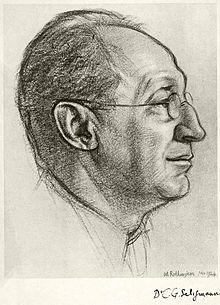Charles Gabriel Seligman | |
|---|---|
 | |
| Born | Charles Gabriel Seligmann 24 December 1873 London, England |
| Died | 19 September 1940 Oxford, England |
| Citizenship | British |
| Alma mater | St Thomas' Hospital |
| Known for | Races of Africa (1930) |
| Scientific career | |
| Fields | Anthropology, history |
Charles Gabriel Seligman FRS[1] FRAI (né Seligmann; 24 December 1873 – 19 September 1940) was a British physician and ethnologist. His main ethnographic work described the culture of the Vedda people of Sri Lanka and the Shilluk people of the Sudan. He was a professor at London School of Economics and was influential to prominent anthropologists, such as Bronisław Malinowski, E. E. Evans-Pritchard, and Meyer Fortes.[2]
Seligman was an advocate and published literature for the Hamitic hypothesis, stating the Cushitic, Berber, and Egyptians were thought to have linage with the speculated, and later debunked, Caucasoid Hamitic people, categorically different to the denoted "Negroids" of Sub-Saharan Africa.[3][4][5] His work in the 1920s and 1930s are now seen as white supremacist.[3]
- ^ Myers, C. S. (1941). "Charles Gabriel Seligman. 1873–1940". Obituary Notices of Fellows of the Royal Society. 3 (10): 627–646. doi:10.1098/rsbm.1941.0026.
- ^ Gaillard, Gérald (2004). The Routledge Dictionary of Anthropologists. Peter James Bowman (trans.) (English translation of Dictionnaire des ethnologues et des anthropologues [1997] ed.). London and New York: Routledge. ISBN 0-415-22825-5. OCLC 52288643.
- ^ a b Moses, Wilson Jeremiah. 1998. Afrotopia: The Roots of African American Popular History. Cambridge University Press, p. 233.
- ^ Spöttel, M. (1998). "German ethnology and antisemitism: The Hamitic hypothesis". Dialectical anthropology, Vol. 23, No. 2 (July 1998), pp. 131–150.
- ^ Dubow, Saul. 1995. Scientific Racism in Modern South Africa. Cambridge University Press, p. 86.